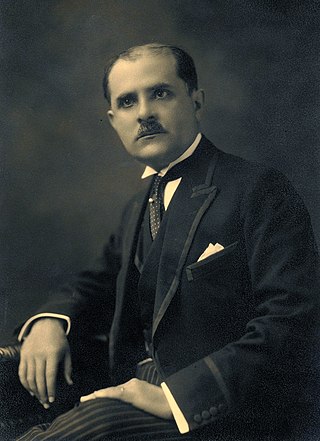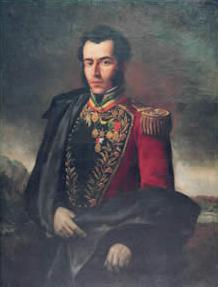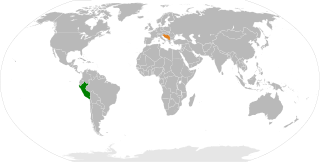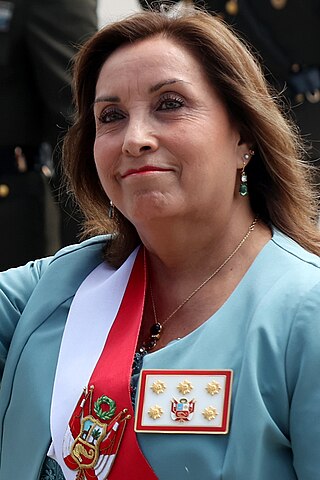Main article: Battle of Junín
The order of battle proceeded as follows:
Contents
- Commander in Chief
- Cavalry Corps
- Infantry Corps
- Commander in Chief 2
- Cavalry Corps 2
- Infantry Corps 2
- See also
- Notes
| |||||
The order of battle proceeded as follows:

Peru is an important first-tier state in South America, Peru has been a member of the United Nations since 1945, and Peruvian Javier Pérez de Cuéllar served as UN Secretary General from 1981 to 1991. Former President Alberto Fujimori's tainted re-election to a third term in June 2000 strained Peru's relations with the United States and with many Latin American and European countries, mainly small countries like Yemen but relations improved with the installation of an interim government in November 2000 and the inauguration of Alejandro Toledo in July 2001.

Pedro Gutiérrez de Valdivia or Valdiva was a Spanish conquistador and the first royal governor of Chile. After serving with the Spanish army in Italy and Flanders, he was sent to South America in 1534, where he served as lieutenant under Francisco Pizarro in Peru, acting as his second in command.

Antonio Raimondi was a prominent Italian-born Peruvian geographer and scientist. Born in Milan, Raimondi emigrated to Peru, arriving on July 28, 1850, at the port of Callao. In 1851 he became a professor of natural history. In 1856, he was one of the founding professors of the medical school at the National University of San Marcos; in 1861, he founded the analytical chemistry department.

The Republic of Peru has two vice presidents, the First Vice President and the Second Vice President, who are elected along with the President in democratic elections. Their only constitutional mission is to replace the President in case of death, permanent or temporary incapacity, resignation, being abroad without the permission of Congress, failure to return from abroad at fixed time, and/or dismissal or removal from office as allowed by the Constitution. They cannot be appointed outside of general elections.

Luis Antonio Eguiguren Escudero was a Peruvian educator, magistrate, historian and politician. He was the director of the General Archive (File) of the Nation (1914), Alderman of Lima (1914–1920), Mayor of Lima (1930), President of the Constituent Congress (1930–1932), founder and leader of the Peruvian Social Democratic Party. He won the Peruvian presidential election of 1936, but his victory was ignored by the Congress and the then-President Oscar R. Benavides, who claimed that he had won with votes of the APRA. He presided over the Supreme Court and the Judiciary in 1953 and 1954.
The term Peruvian literature not only refers to literature produced in the independent Republic of Peru, but also to literature produced in the Viceroyalty of Peru during the country's colonial period, and to oral artistic forms created by diverse ethnic groups that existed in the area during the prehispanic period, such as the Quechua, the Aymara and the Chanka South American native groups.

The order of battle for the Battle of Ayacucho proceeded as follows:

The Salaverry-Santa Cruz War, sometimes called the Peruvian Civil War of 1835–1836, was an internal conflict in Peru with the involvement of the Bolivian army of Andres de Santa Cruz. At the Battle of Yanacocha, Santa Cruz's army lost 211 men and 71 wounded, while Gamarra's army lost 400 men and 985 taken prisoner. At the Battle of Uchumayo, Santa Cruz's army lost 315 men.

Peru and Spain established diplomatic relations in 1879. Both nations are members of the Association of Academies of the Spanish Language, Organization of Ibero-American States and the United Nations.

Manuel Arturo Merino de Lama is a Peruvian politician who briefly served as President of Peru for six days between 10 and 15 November 2020. He also served as the President of Congress from 16 March 2020 to 15 November 2020. He was a Member of Congress (AP) representing the Tumbes constituency for the 2001–2006, 2011–2016, and 2020–2021 terms.

Together for Peru is a Peruvian centre-left to left-wing political coalition founded with the incumbent registration of the Peruvian Humanist Party.

Peru–Yugoslavia relations were historical foreign relations between Peru and Yugoslavia. Both countries had amicable relations and were active in the Non-Aligned Movement which was established in Belgrade in 1961. Peru had an embassy in Belgrade until 2006 and Yugoslavia, later Serbia, had an embassy in Lima until 2009.

Dina Ercilia Boluarte Zegarra is a Peruvian politician, civil servant, and lawyer currently serving as the President of Peru since 7 December 2022. She had served as the first vice president and minister at the Ministry of Development and Social Inclusion under President Pedro Castillo. She served as an officer at the National Registry of Identification and Civil Status (RENIEC) from 2007 until 2022. With Boluarte assuming the presidency as the sole vice president, President of Congress Alejandro Soto Reyes is next in the line of succession.

Following the ousting of president of Peru, Pedro Castillo on 7 December 2022, a series of political protests against the government of president Dina Boluarte and the Congress of Peru occurred. The demonstrations lack centralized leadership and originated primarily among grassroots movements and social organizations on the left to far-left, as well as indigenous communities, who feel politically disenfranchised. Castillo was removed from office and arrested after announcing the dissolution of Congress, the intervention of the state apparatus, and the establishment of an "emergency government", which was characterized as a self-coup attempt by some media organizations and institutions in Peru while Castillo's supporters said that Congress attempted to overthrow Castillo. Castillo's successor Dina Boluarte, along with Congress, were widely disapproved, with the two receiving the lowest approval ratings among public offices in the Americas. Among the main demands of the demonstrators are the dissolution of Congress, the resignation of Boluarte, new general elections, the release of Castillo, and the formation of a constituent assembly to draft a new constitution. It has also been reported that some of the protesters have declared an insurgency. Analysts, businesses, and voters said that immediate elections are necessary to prevent future unrest, although many establishment political parties have little public support.